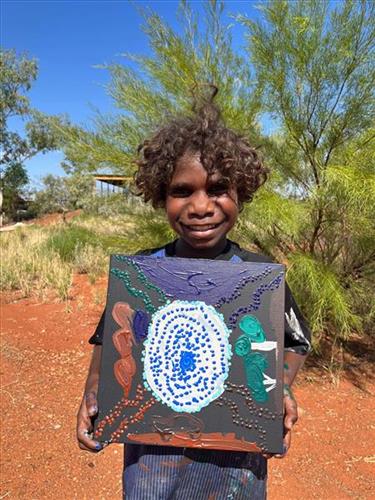111582213963
Desert Queen Baths (Wuputirlitirli)
“That’s my father’s place in Karlamilyi (Rudall River region). There is a quiet snake there and water all the time, from pujiman (traditional, desert dwelling) days to today. There is a little river passing through this area. The snake always lives here. It’s a red snake with a short tail, Wartararra. The bird is karuwalkan (kookaburra), it is landing on the yurungkura (red river gum), it’s making the tree move. He from Jukurrpa (Dreaming), that fella. Sometimes when we sleep in the river there, he’ll sing out ‘Kuurr Kuurr Kuurr’. He’ll wake us up. Everybody get up! Something must be coming into my father’s Country. It’s my Country, Warnman Country, it’s inside me. The Country is full of colour, I can show all of that colour with my paintings.”
– Wurta Amy French
Wuputirlitirli is a series of rockholes and a cave located in the heart of the Karlamilyi River region, and north of Karlamilyi River. This site was an important meeting area during the pujiman (traditional, desert dwelling) era. Wuputirlitirli lies within Wurta’s ngurra (home Country, camp), the area which she knew intimately and travelled extensively with her family in her youth.
As Wurta recounts, Wuputirlitirli is home to an ancestral kookaburra and jila (snake). The Western Desert term jila is used interchangeably to describe springs considered to be ‘living’ waters and snakes, both of which play a central role in Martu culture and Jukurrpa. During the pujiman period, knowledge of water sources was critical for survival, and today Martu Country is still defined in terms of the location of water sources. Of the many permanent springs in Martu Country, very few are ‘living waters’; waters inhabited by ancestral jila (snakes). Before they became snakes, these beings were men who made rain, formed the land and introduced cultural practices like ceremonies and ritual songs. Some of the men travelled the desert together, visiting one another, but they all ended their journeys at their chosen spring alone, transformed into a snake. These important springs are named after their jila inhabitant, guarding their waters.
Some of the jila snakes are known by Martu as quiet and benevolent, others as dangerous and ‘cheeky’. Regardless of the nature of the inhabitant snake, jila sites must be entered respectfully; particular rituals are practiced, such as lighting fires, sweeping the ground with branches, approaching in single file, and calling out to the site’s jila to announce one’s arrival and introduce people who are new to the jila. Those who do not follow these guidelines are in danger of becoming sick, or even being killed.




